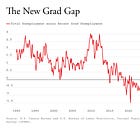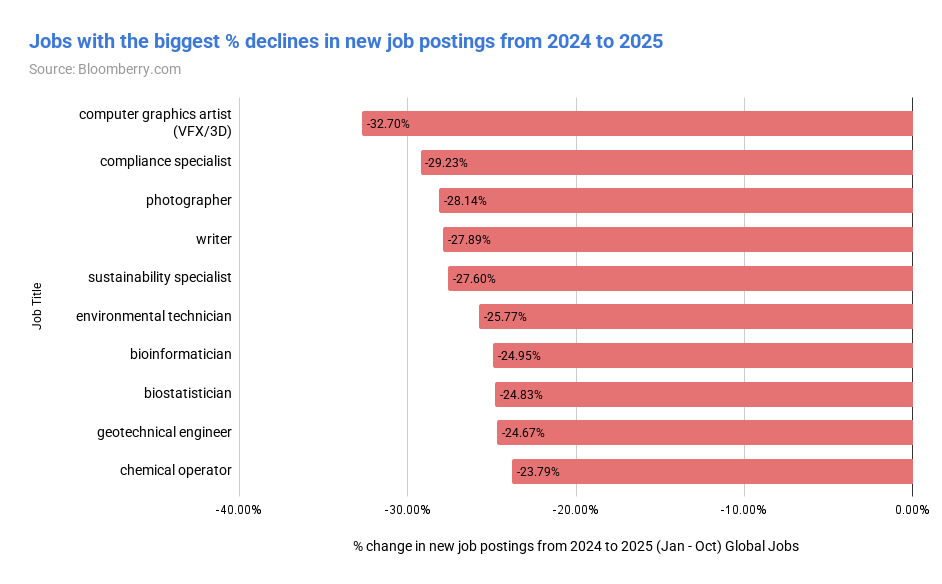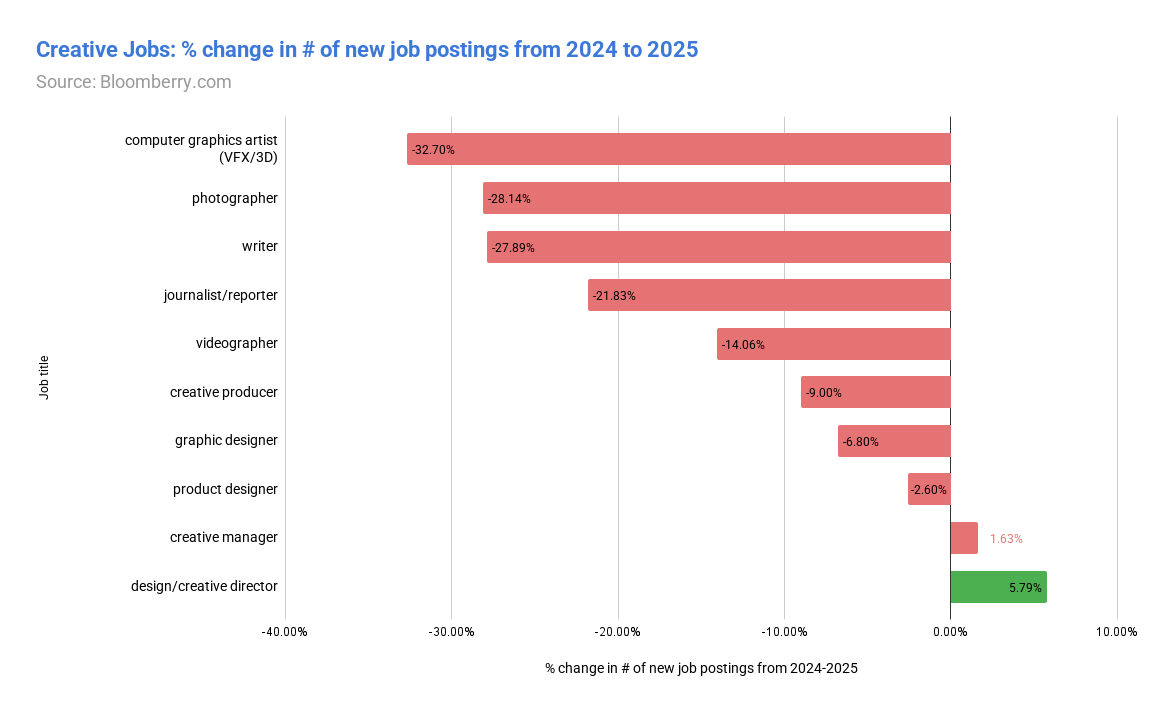What’s really going on with AI and jobs?
Record-breaking layoff reports, Amazon's mass firings, and a slump in entry level employment. Is AI behind it all?
Today, we tackle the second biggest question on everyone’s minds when it comes to AI: That is, how is AI *really* impacting jobs?
First, the obligatory note that this work is made 100% possible by subscribers who chip in $6 a month or $60 annually, about a coffee a month or oh a nice lunch out a year. That backing not only funds my reporting, researching, and writing (and now a live chat slash podcast enterprise to boot) but also my ability to share this work with students, organizers, and the broader public. A big thanks to all of you who already pitch in. And to those readers who aren’t yet doing so, but are able, please consider becoming a paid backer, so I can do more of it. Cheers everyone—onwards.
The “AI jobs question” has been overshadowed of late by the “AI bubble question” but it’s rarely been far from view. In fact, it reared its head again when a new report from a global outplacement firm found that 153,000 jobs had been cut in October, the highest number for that month since 2003, and also when Amazon announced tens of thousands of job cuts and executive leadership pointed to advances in AI as the motivating factor. (Salesforce made a similar move in September, laying off 4,000 workers because, as CEO Marc Benoiff said “I need less heads” with AI, and companies like Duolingo and Klarna did the same some months before.)
The layoff report, from Challenger, Gray & Christmas, finds that US based employers announced 175% more job cuts this October than last year, and that 2025 has now seen the most firings of any year since 2020. The report notes that this is unusual, as most companies typically avoid year-end layoff announcements to avoid bad press, and that the firings arrive “as AI adoption, softening consumer and corporate spending, and rising costs drive belt-tightening and hiring freezes.”
From the report:
In October alone, Cost-Cutting was the top reason employers cited for job reductions, responsible for 50,437 announced layoffs. Artificial Intelligence (AI) was the second-most cited factor, leading to 31,039 job cuts as companies continue to restructure and automate. AI has been cited for 48,414 job cuts this year.
The October Amazon firings certainly fit the bill. Amazon SVP Beth Galetti wrote in a memo accompanying the layoff announcement that “AI is the most transformative technology we’ve seen since the Internet” and as such Amazon needs “to be organized more leanly, with fewer layers and more ownership.” (She’s really saying the quiet part out loud there, and that’s a pretty good boiling down of the pitch for AI automation in general, come to think of it. Fewer layers—more ownership. Fewer workers—more profit.) In other words, AI is driving the cost-cutting, perhaps hitting both of the above buckets at once.
Yet impacted Amazon employees pushed back on the company’s AI narrative. Some took the extraordinary step of publishing a statement to the contrary: “Everyone I work with says the AI they’ve been required to use has not made them significantly more productive,” one Amazon engineer wrote in a press release. “I think they just want to keep up the AI hype, and signal to other companies that they can cut payroll too if they go all in on AI. Either way, we’re the ones paying the price.”
As readers of BITM will know, much of the job loss from AI has thus far seems to have unfolded in cases like this, where “AI” is deployed not so much as a technology functionally capable of replacing human labor in toto, but as a logic and an ideological justification for management’s ulterior goals. Where management wants to cut labor costs a la Amazon, shift to cheaper contract labor a la Klarna, or execute layoffs for ideological reasons, a la DOGE, “AI” is an extremely potent justification. Some business professors and analysts have taken to calling this practice “AI-washing.” If Amazon is firing 30,000 workers because its technology is so cutting edge that its AI systems can ably replace them, investors will be a lot happier than if Amazon is cutting costs because, say, it’s over-leveraging itself on data center expansion or its worried about earnings.
In short, it’s still pretty hard to say whether these kinds of job losses will be permanent, whether firms will have to rehire the workers it shed if and when the AI tools management is touting don’t pan out, and so on. After all, it’s only been a couple months since a major MIT report found that 95% of companies that invested in generative AI did not profit at all from the investment. (The paper found that enterprise grade AI systems “fail due to brittle workflows, lack of contextual learning, and misalignment with day-to-day operations.”) What is clear is that AI is regardless a powerful way for bosses to exert leverage over workers, depress wages, and effect layoffs.
And surely *something* is happening to the larger jobs picture, that’s clear enough. That picture is muddied by the fact that the Bureau of Labor Statistics isn’t publishing federal jobs reports due to the government shutdown, and we have to rely on findings from private firms with less access to the full picture. (On that front, the payroll processing company ADP released a report this week showing *some* private job growth, with 42,000 jobs added, but far less than this time last year.)
Whether due to prolonged tariff uncertainty/madness, general economic contraction, or firms holding off on hiring while they decide on a longer-term AI strategy, there are indeed some persistently worrying economic trends. (The ADP report cites falling jobs in recreation/leisure, as a worrying sign consumer spending is down.) The most-discussed, however, is probably the shrinking number of jobs for recent college grads. Derek Thompson pointed to this trend in an Atlantic piece that argued there were signs that “AI is competing with recent college grads” and a trio of Stanford economists published a paper asserting that early career employment for US workers in “occupations exposed generative AI” aged 22-25 had declined in key fields 13% since 2022, precisely when the commercial technology entered the scene.
This is still pretty speculative, as the paper itself allows, and is a rather short timeline to draw any sweeping conclusions from. Its lead author, Erik Brynjolfsson, is also the founder of a startup that sells software that purports to help organizations “identify the tasks, jobs, and functions that can be most improved via GenAI” and the paper describes the phenomenon the study is examining as “the AI revolution,” so we might be wary of a level of confirmation bias at play here. Its key findings—that there are fewer jobs for entry level US workers in fields like software engineering, could also be explained by outsourcing, a wait-and-see approach to AI hype rather than an embrace of AI tools to replace labor, and so on. (The paper notes this too.) Furthermore, the dip really doesn’t seem that dramatic to me since 2021. And as above, it seems unclear whether the changes will be structural or fleeting, or whether there will be a durable “AI revolution” with regard to labor at all.
What we can be sure of, however, is that there is real pain unfolding right now, irregardless of whether it’s due to management enacting bona fide AI job replacement, executives’ hopes that AI can cut labor costs, or “AI washing” that obscures a company’s ulterior motives. I can be sure of this not just because I’ve personally heard hundreds of testimonials from workers dealing with AI in their workplaces or competing with its output, but also because of a new analysis that aims to hone in on what kind of jobs are being impacted, right now.
Henley Chiu, the CTO and co-founder of Revealera, similarly felt that there was too much broad speculation over the “AI jobs question” and that there weren’t enough efforts being made to drill down into the specifics. So Chiu built a program to analyze 180 million global job listings, with the intent to determine which fields had seen declines or growth, and reached out to me to share the findings. (Thanks Henley!)
Similar caveats to the Stanford study apply here—and there could be a number of reasons that a given field saw the number of job postings rise or fall over the last two years—but it’s another source of data to consider. And much of it comports with trends I’ve seen anecdotally in my recent reporting, and from the stories submitted to AI Killed My Jobs.
First, Chiu finds that there’s been an 8% drop in job postings around the world, year-over-year. That’s similar to what Indeed reported (7.3%). “There’s simply less jobs created this year than last,” Chiu tells me, “and less job postings too.” As he writes in his report, “Could AI be partly responsible for this overall 8% decline? Maybe—but that’s nearly impossible to separate from macro factors. So this analysis focuses on jobs with dramatic deviations from the market trend, where AI’s impact is most clear.”
To that end, Chiu goes on to detail the job postings worldwide that have fallen off most drastically in the last two years. Surprise: The pack is led by creative jobs, as well as sustainability and compliance roles.
There’s real reason to suspect that computer graphic artist, photographer, and writing jobs are being impacted by AI. (It’s probably just as clear why those compliance jobs postings are dropping off, given the Trump administration’s bulldozing of sustainability regulations that make compliance redundant.)
There’s also reason to fear that AI-enamored media firms might be posting fewer job listings, both given the state of the industry and the hope that AI tools and features can pick up some of the slack.
Chiu shares his parsing of the findings:
Among the top 10 declining roles, 3 are creative positions: computer graphic artists (-33%), photographers (-28%), and writers (-28%). Computer graphic artists includes roles such as technical artists, 3d artists, and VFX artists. Writers include copywriters, copy editors and technical writers.
Just outside the top 10, journalists/reporters (-22%) is also experiencing a decline.
This isn’t a one-year blip, unfortunately. These appear to be 2 year declines. Computer graphic artists have fallen for two straight years (down 12% in 2024, then another 33% in 2025). Photographers and writers followed the same pattern.
Again, we can’t necessarily or conclusively attribute these trendlines to AI, but they’re just the way the numbers would break if firms were turning to AI tools to automate the production of art, copy, and text. Chiu also points out that while job listings for writers, artists, and creatives have declined, listings for creative directors have grown. This is precisely what you would expect to see as management embraced AI: fewer people actually creating the work, and more people in management roles overseeing the automated production.
Elsewhere, Chiu noted that job listings for medical scribes—a role he says may be replaceable with AI—were down 20% from 2024 to 2025, as well. But while he did note a drop among listings for frontend and mobile software engineers, the rest of the field seemed resilient (contra the Stanford study’s findings; though that was US-based, and Chiu’s examining global trends). Perhaps predictably, machine learning engineers saw the biggest leap in job listings, at a 40% bump. Chiu concludes that “AI isn’t causing huge spikes in unemployment,” noting that “most jobs in our analysis did not drastically plummet. But it’s insincere to say AI is having zero impact either. Its impact is selective. It’s hitting some creative work hard.”
This, as BITM readers might notice, generally aligns with my read of what’s happening as well. As the MIT study and Chiu’s work both highlight, generative AI is not reliable enough when it comes executing complex tasks to enable most organizations to displace jobs at scale, and it certainly can’t do jobs that require empathy or hands-on problem-solving. What it can do is automate the production of work that need not be “reliable” or “accurate,” but that employers might find “good enough.” Precisely the way many corporate executives already conceive of creative work, in other words. And it can inspire overzealous executives, or managers who wanted to induce layoffs or cost-cutting anyway, to pull the trigger.
In sum, and not to just end here having confirmed my priors, the answer to the lead-off question “what the hell is happening with AI and jobs?” is the deeply unsatisfactory “management is using it in various ways, both as a buzzy ideological framework and an actual automation technology, to achieve various ends, including but far from limited to job replacement.”
We know there’s some combination of “AI washing” and labor replacement taking place, and that both may be joining forces with tariffs, political instability and economic contraction to limit opportunities, especially for entry level knowledge workers. And we know that it’s a useful tool for management to exert leverage, depress wages, and consolidate control, regardless. What the hell is happening with AI and jobs? What isn’t happening with AI and jobs, more like. At least one thing seems clear: Bosses are using it the way they’ve used automation technologies since the Industrial Revolution—to extract maximum value from workers, and to profit from the profound uncertainty around the true extent of its power and utility.








Please stop saying irregardless, it’s regardless.
Less jobs in customer support too, I suspect. And all these 'less jobs' translate to a shittier experience by customers (anybody enjoy the clueless chatbot?) and less cost for the company. But that was already happening before GenAI.